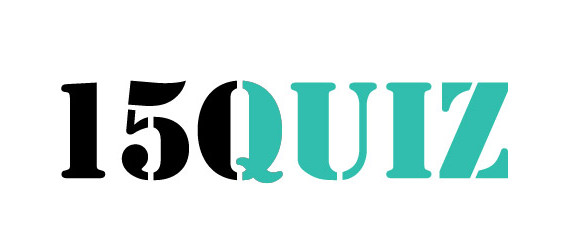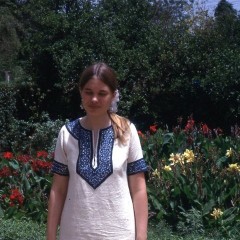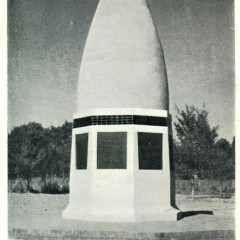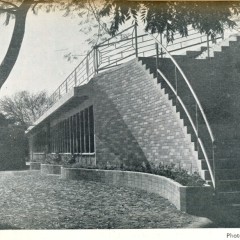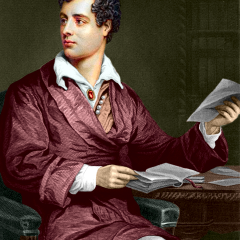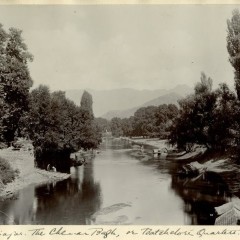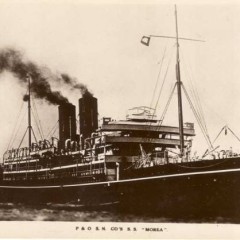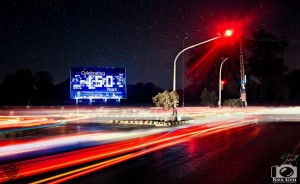The Good Old Days
By Anne Tebbe Kidd By the time my father, Dr Robert Tebbe, accepted an appointment to serve as principal at FC College, my three older brothers had already returned to the US. Instead of a family with five children, my parents moved to Lahore with their two daughters, Anne and Margaret. For me, the move opened up a whole new set of experiences in Pakistan. During the years my father worked at Gordon College in the heart of the bustling city of Rawalpindi, my sister and I had been mostly restricted to our residential compound. Although leaving our friends in Rawalpindi was hard, coming to the spacious peace of FCC campus gave my sister and me freedoms we had never before known in Pakistan. It was a time of building new relationships and having different experiences … like swimming in the campus pool, albeit a pool in desperate need of clean water; biking and walking through the residential parts of the campus without chaperones; and going to movies or bazaars with a new friend (the wife of a junior professor). My mother, a highly social person, had an insatiable interest in knowing and being a friend to all. One memory I have of our time at FCC is the several days of tea parties over the Christmas season that enabled our family to invite all faculty members and their spouses in for a few hours. My mother saw the faculty families as her extended family so she wanted to be sure she had a chance to share a bit of holiday cheer. My sister and I were pressed into service for these teas, which may be why they stand out in my memory. My mother managed the guest list to be sure the faculty whose wives observed purdah could attend by dividing the list so the number of wives in purdah attending each of the days could be accommodated in the study. What has stayed with me since I left Pakistan so many years ago is the feeling of goodwill and community among the staff and families at FCC. I loved our life there. Last month the Tebbe children moved my 92-year old mother who now lives in Lakeland, Florida, USA, from her house to a more convenient apartment. One of my brothers claimed the big tea tray she had kept since her FC College days. It was the tray she said she used to serve “hundreds of cups of tea.” Though hundreds of cups of tea may have been served from her tray, all of us shared memories of the thousands of cups of tea we enjoyed with others...
Unveiling of Memorial Pillar at New Site 1936
After luncheon at the new site [the current campus], on December the 20th, 1936, Dr. S. K. Dutta conducted the gathering to the Memorial Pillar, where it stood like a gigantic finger pointing to the heaven, a silent testimony to the selfless work of Dr. C. W. Forman, the Founder of this College, and his successors. The Principal guided the company and, stopping at each tablet, read out its contents. On the first tablet was a history of the College and the date of its foundation and of the erection of the Pillar. The next tablet contained a list of five names – mere names and no more. But names that mean much to every Formanite – Dr. C. W. Forman, the Founder of this College, Dr. H.C. Velte, Sir James Ewing, Dr H.D. Griswold, Dr. J. H. Orbison, all of whom occupy a definite niche in the fifty years of existence of the Forman Christian College. The third tablet again contained names and no more. But each of these names signifies the progressive evolution of this College, as it advanced step by step, from a College with fifteen students to a College now containing over one thousand students. Forman, Ewing, Lucas, Dutta – all stepping-stones in the progress of the College; significant of what the College was and what it will be. With the erection of this Memorial Pillar we ring down the curtain over the fifty years of service of this College. M. C. Sanyal (Assistant Editor, The Folio, FCC Magazine, 1936-37) Source of text and image: The Folio, FCC Magazine, Vol. XXVIII, January 1937 to February 1937. Notes: Dr Sufian Aslam (FCC 1968-1972), Dean of Sciences, remembers seeing this monument when he was a student at FCC. It was on the land which currently has the PCSIR buildings. The monument was pulled down when the boundary wall was...
The Student Centre 1963
The structure nearing completion (as of February, 1963) in the physical education sector of the Forman Christian College campus has the distinction of having been praised and condemned already in the strongest terms possible by the large number of amateur critics who have observed the growth of the building. Adverse reactions go so far as to compare it with a third class waiting hall or a stable. Favourable comments are inclined to reflect as unrestrained a response on the other side. It would be safe to say, at the least, that the appearance of the building has not passed unnoticed. The concept of the Lucas Student Centre originated in the Report of the Commission on National Education with its emphasis on the need for developing facilities for students on a larger scale than hitherto existed. The willingness of the Government of Pakistan to make funds available made it possible to bring this multipurpose building into existence, while the creative planning and design of the Engineering Department of the United Christian Hospital, under the guidance of its head, Mr. Le Young, gave form to the vaguely conceived ideas of the college planners. The movement from concept to completion is almost finished. Mr. Young has designed a building that provides the Physical Education Department with an outdoor gymnasium, playing court, shower and locker rooms and an office. Part of the building houses community service facilities, such as barbering, tailoring, cycle repairing and a book and stationery shop. Refreshment rooms will be confined to a tea shop and fruit shop for the present, although further expansion is possible which would include a full cafeteria system dining room and kitchen. Student and staff lounges and further office space are included. Finally, the roof has been designed as a tiered stadium for both the athletic playing field in front of the Centre and the enclosed gymnasium within. Lighting has been provided for night games and functions. The design of the Centre is a major point of controversy. The person who has seen the building may be somewhat startled by the claim that the design does conform to the standard set by Mughal architecture and follows some of its major principles, if these are accepted as consisting of a sense of austerity, formality, balance, colour and, finally, the architectural value of sincerity. With respect to the first two characteristics, the building clearly suggests a formal and austere design. The long straight line and the severe 90° angle dominate the structure. Balance is achieved in a manner quite different from that used by the Mughals. Shahjahan thought of balance as symmetry; in the Student Centre balance...
Lord Byron’s Lost Letter
In the last Will and Testament of the late Rev. W. J. P. Morrison, M. A., it was provided that three hundred volumes of his library should be given to the F. C. College. For the purpose of making a selection of these books, we [Dr. Griswold et. al.] went to Dehra [Dun], on the 17th ultimo, and spent an entire day in choosing from some two thousand volumes, the three hundred best suited to our needs. These will soon be on our shelves and will constitute a very valuable addition to our Library. Among the books referred to is a copy of Byron’s complete works published in 1826. At sight of this old volume the archaeological instincts of our companion were stirred and he proceeded to glance through the book, when he was rewarded by discovering, pasted within the front cover, an autograph letter of Lord Byron, written from Venice on April 27th, 1819. How the letter came to be placed within that book, and through whose hands the treasure may have passed during the years since it was written, we shall probably never know. The letter is in a good state of preservation, and its contents consist of a very sprightly protest upon the part of the poet, against a statement which been made to the effect that he was the author of a certain book and had lived in a certain place. We here give it in full: Sir, In various numbers of your journal I have seen mentioned a work entitled “The Vampire” with the addition of my name as that of the author. I am not the author, and never heard of the work in question until now. In a more recent paper I perceive a formal annunciation of “The Vampire,” with the addition of an account of my “residence in the Island of Mitylene,” an Island which I have occasionally sailed by in the course of travelling some years ago through the Levant, and where I should have no objection to reside, but where I have never yet resided. Neither of these performances are mine, and I presume that it is neither unjust nor ungracious to request that you will favour me by contradicting the advertisement to which I allude. If the book is clever it would be base to deprive the real writer, whoever he may be, of his honours; and if stupid, I desire the responsibility of nobody’s dulness [sic] but my own. You will excuse the trouble I give you; the imputation is of no great importance, —and as long as it was confined to surmises and reports—I should have received it...
Prof Benade’s Wedding 1922
Mr. and Mrs. P. H. Benade of Donaghy Avenue [Big Run, Pennsylvania] have received a letter from India, telling of the marriage of their son, James Martin Benade to Miss Miriam McGaw, both of whom are doing missionary work under the Presbyterian Board of Missions. The letter describes the ceremony as follows: James Martin Benade and Miss Miriam McGaw, teacher in Mary Wanamaker High School at Allahabad, were united in marriage on June 27th, 1922, at Srinagar, Kashmere. The ceremony was performed under a huge old chinar tree, the decorations being cattails and pink dahlias with glossy green lotus leaves forming a semi-circle under the tree. Small tea tables and chairs were placed inside and a path from the tent to the circle was bordered with lotus leaves. The bride carried a bouquet of lotus blossoms. Rev. A. G. McGaw, father of the bride, performed the ceremony. Delicious refreshments were served to the many guests and pictures were taken. After spending their honeymoon in Kashmere, they will be at home at the The Abbey, Napier Road, Lahore, India. Mr Benade is a graduate of Grove City College and Princeton University and is head of the department of Physics of the Forman College at Lahore. The bride, who is the daughter of Dr. and Mrs. A. G. McGaw Presbyterian missionaries, was educated at Wooster College. Mr. and Mrs. Benade will remain in India until 1926. Text: Big Run Tribune, 1922. Copied from the original by F Raihan, 1958. Image: “View of Srinagar, Kashmir – Circa 1900” courtesy of...
Letter from India 1912
Lahore, India, Oct. 3rd. 1912. Dear Friends in Big Run: In accordance with a request of your editor, I am writing a short sketch of my voyage, which I hope may be of interest to some. At 6:45 a.m. Aug. 7th, 1912, I left Big Run for New York, via Williams Port, Reading and Philadelphia, stopping off at each place for a few hours. At 6:00 p.m. Thursday, when I landed from the 23rd St. ferry in New York, I found waiting for me, Mr. Irvin Rogers, formerly of Big Run, Mr. R. S. Boots and Mr. C. R. Daubenspeck. Having seen as much of the city as possible, I sailed for Southampton on the Oceanic at noon, Aug. 10. We lost sight of land at about 4:00 p.m. and saw only water and sky, with an occasional boat between, for the next six and a half days. The weather was cold and damp during about half the Atlantic trip, and the other half was warm and sunny. There were deck games outside and cards inside, for those who were interested. There was also a good library and plenty of pens, ink and paper for those who preferred to indulge. The constant vibration of the boat, due to the engines, afforded a ready excuse for illegible writing. At 7:30, Saturday morning, some of our passengers were landed at Plymouth; other left us at Cherbourg at about noon and the rest of us landed at Southampton at about 6:30. We had about 67 second class passengers many of them only third class people. There were about 57 varieties, little, middle and big; good, bad, and indifferent. A fat mill owner, a thin man who was intoxicated most of the time and wanted to talk politics all the time; a “manufacturer” of antiques and a girl not especially noticeable for beauty who was quick to take every opportunity to talk with the sailors or any other young man who would not avoid her. There was a young English lady, not more than 45 and unmarried, who spent part of her time trying to get a definition for “love” from the men. I suppose such people are to be found everywhere. The special train which took us to London was rather interesting to me. It was made up of about 12 “carriages” each of which had three compartments, and it was mounted on four light wheels. The locomotive weighs about 40 tons but seemed to haul the light train with ease. The largest English cars I saw are not half as large as the ordinary American cars. The coal cars, “goods cars” and...


